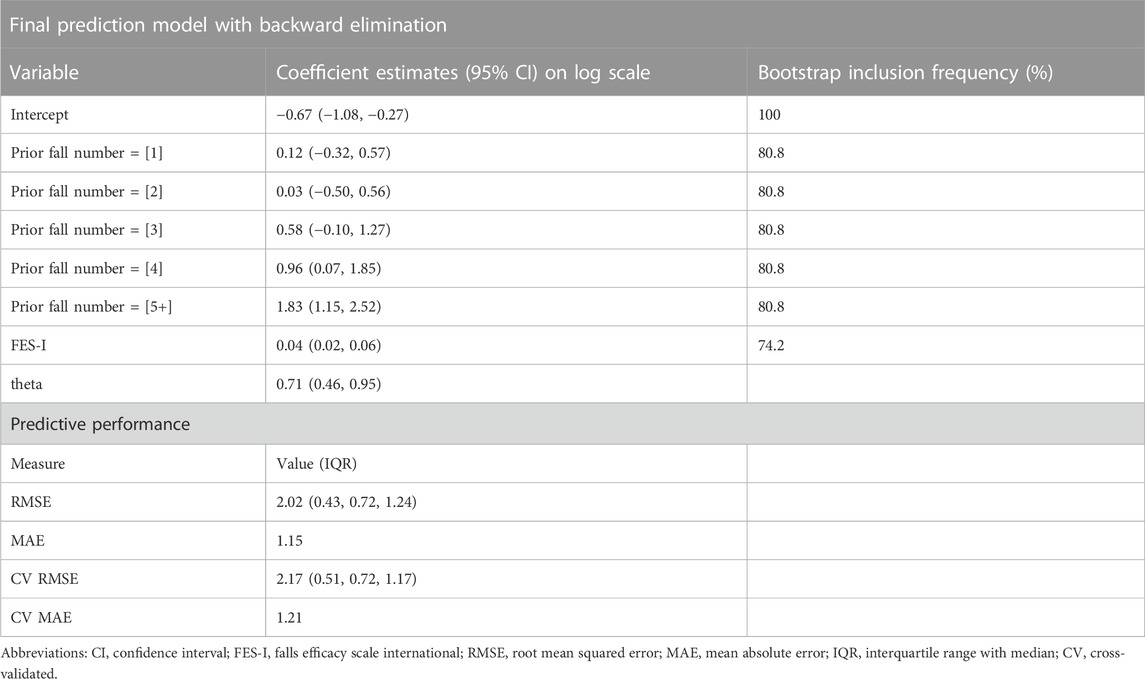- 1ARTORG Center for Biomedical Engineering Research, University of Bern, Bern, Switzerland
- 2HES-SO Valais-Wallis, School of Health Sciences of Physiotherapy, Leukerbad, Switzerland
A Corrigendum on
History of falls and fear of falling are predictive of future falls: outcome of a fall rate model applied to the Swiss CHEF trial cohort
by Wapp C, Mittaz Hager A-G, Hilfiker R and Zysset P (2022). Front. Aging 3:1056779. doi: 10.3389/fragi.2022.1056779
In the published article, there was an error in Table 3 as published. The root mean squared error (RMSE) and its interquartile range (IQR) stated as 0.93 (0.58, 0.92, 1.06) is wrong. The corrected numbers are 2.02 (0.43, 0.72, 1.24). The mean absolute error (MAE) stated for the backward elimination model states as 0.84 is wrong. The corrected number is 1.15. The corrected Table 3 and its caption “Coefficients, bootstrap inclusion frequency, and predictive performance for the backward elimination model.” appear below.

TABLE 3. Coefficients, bootstrap inclusion frequency, and predictive performance for the backward elimination model.
Accoringly, a correction has been made to Results, paragraph 5. This sentence previously stated:
“The RMSE and MAE were 0.93 and 0.84, respectively; internal cross-validation increased these values to 2.17 and 1.21, respectively.”
The corrected sentence appears below:
“The RMSE and MAE were 2.02 and 1.15, respectively; internal cross-validation increased these values to 2.17 and 1.21, respectively.”
The authors apologize for this error and state that this does not change the scientific conclusions of the article in any way. The original article has been updated.
Publisher’s note
All claims expressed in this article are solely those of the authors and do not necessarily represent those of their affiliated organizations, or those of the publisher, the editors and the reviewers. Any product that may be evaluated in this article, or claim that may be made by its manufacturer, is not guaranteed or endorsed by the publisher.
Keywords: older adults, falls, prediction, risk factors, count regression
Citation: Wapp C, Mittaz Hager A-G, Hilfiker R and Zysset P (2023) Corrigendum: History of falls and fear of falling are predictive of future falls: Outcome of a fall rate model applied to the Swiss CHEF trial cohort. Front. Aging 4:1235431. doi: 10.3389/fragi.2023.1235431
Received: 06 June 2023; Accepted: 20 June 2023;
Published: 06 July 2023.
Edited and reviewed by:
Feng Yang, Georgia State University, United StatesCopyright © 2023 Wapp, Mittaz Hager, Hilfiker and Zysset. This is an open-access article distributed under the terms of the Creative Commons Attribution License (CC BY). The use, distribution or reproduction in other forums is permitted, provided the original author(s) and the copyright owner(s) are credited and that the original publication in this journal is cited, in accordance with accepted academic practice. No use, distribution or reproduction is permitted which does not comply with these terms.
*Correspondence: Christina Wapp, Y2hyaXN0aW5hLndhcHBAdW5pYmUuY2g=
 Christina Wapp
Christina Wapp Anne-Gabrielle Mittaz Hager
Anne-Gabrielle Mittaz Hager Roger Hilfiker
Roger Hilfiker Philippe Zysset1
Philippe Zysset1